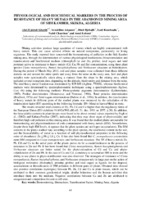PHYSIOLOGICAL AND BIOCHEMICAL MARKERS IN THE PROCESS OF RESISTANCE OF HEAVY METALS IN THE ABANDONED MINING AREA OF SIDI KAMBER, SKIKDA, ALGERIA

Ver/
Fecha
2018Autor
Gherib, Abd El-fatteh
Aissaoui, Azzeddine
Djebaili, Hind
Bouchaala, Laid
Charchar, Nabil
Lehout, Amel
Metadatos
Mostrar el registro completo del ítemResumen
Mining activities produce large quantities of wastes which are highly contaminated with
heavy metals. This can cause adverse effects on natural ecosystems, particularly on living
organisms. The study reported here concerned the biomonitoring of pollution in the Sidi Kamber
mining area, through the determination of various physiological mechanisms (bioaccumulation and
translocation) and biochemical markers (chlorophyll (a) and (b), proline, total sugars and total
proteins) active in resistance to heavy metals (Cd, Cu, Pb and Zn) contamination, using three plant
species Cistus monspeliensis, Rumex bucephalophorus and Verbascum sinuatum as bioindicators.
